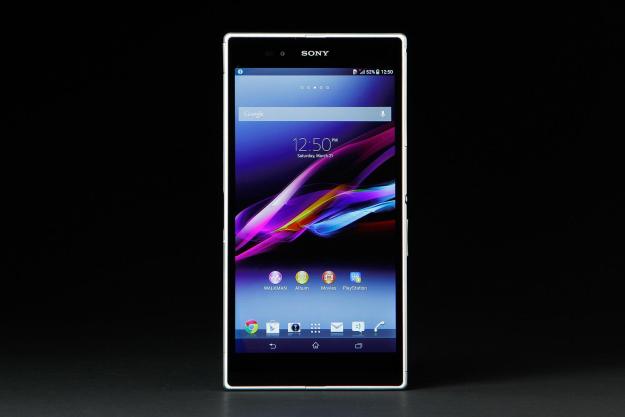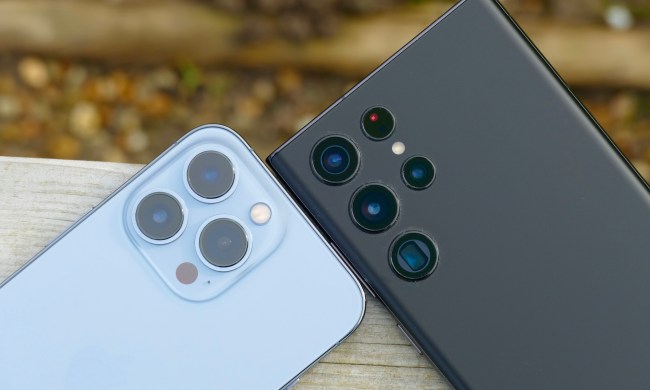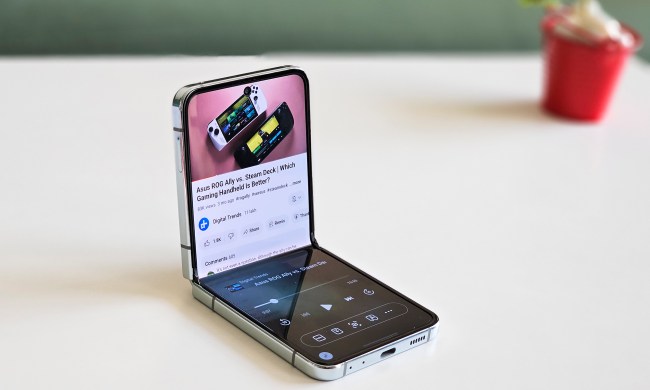
“Sony’s Xperia Z Ultra has a powerful processor and jaw-dropping 6.4-inch screen, but its camera, battery life, single speaker, camera, and sheer size make it just too big and boxy to use comfortably.”
- Huge 6.4-inch screen great for games and movies
- Top-notch specs make for snappy performance
- Touchscreen works with a standard pencil
- Premium look and feel
- Impressively thin
- Disappointing camera with no flash
- Glass over the screen is to reflective
- Poorly placed speaker doesn’t get loud enough
- Awkward to hold due to size, slippery-ness, and square edges
Welcome to the world of big-screen smartphones, more commonly referred to as phablets. Samsung’s feature-packed Galaxy Note 3 has a 5.7-inch screen leads the category, which includes devices like the HTC One Max, Nokia Lumia 1520, and Samsung Galaxy Mega.
This phone isn’t going to fit in your pocket unless you have very large pockets.
Sony’s Xperia Z Ultra outsizes those other models with a gorgeous 6.4-inch, 1080p screen that, in most environments, looks outstanding. It also performs like a champ, thanks to its Snapdragon 800 processor, which also powers LG’s G2.
The Z Ultra is certainly a sleek, slick-looking (and -feeling) device, with some unique features that make it stand out from the big-screen smartphone pack. But it also has some flaws that may make you consider alternative devices – especially since a US carrier hasn’t picked up the Z Ultra. The HSPA+ (3G) model we tested sells for $650, while the 4G LTE version is priced at $680.
A familiar Xperia
If you’re familiar with other recent Sony portable products, like the Xperia Z
It’s huge: The Z Ultra is surprisingly thin, at 0.26 inches. But it’s also 3.62 inches wide and 7.04 inches tall. That means this phone isn’t going to fit in your pocket unless you have very large pockets. Also, while we don’t mind the Xperia line’s rectangular shape on smaller phones or a tablet that will generally be held with two hands, here, the corners make the phone more uncomfortable and unwieldy to handle than it could be.
Slippery back: The slick, glossy back, which feels as slippery as its glass front touchscreen, makes the phone not only easier to accidentally drop from your hand, but more likely to slip off of uneven surfaces when you set it down as well. You’ll definitely want a case for this phone, which will make it even bigger.
Color options: The Z Ultra doesn’t feel top- or bottom-heavy. And while you won’t get as many color options as the iPhone 5C or the Moto X, the Z Ultra does come in white, black, or purple.
Waterproof: Also like most recent Xperia devices, the Z Ultra is waterproof, with an IP58 rating that means it should survive in up to 1.5 meters of water for up to 30 minutes. To make that possible, though, Sony covered most of the ports with rubber-gasketed, aluminum doors that you’ll have to pop on and off when charging, or inserting a microSD card or SIM. The battery is also sealed, which isn’t ideal, especially considering battery life isn’t great.
The edges of the Z Ultra are trimmed in brushed aluminum, and the buttons are also metal, which adds to the phone’s impressively premium-looking aesthetics.
Good button placement: On the right edge, holding the Z Ultra in portrait orientation, there’s a headphone jack up top, and the SIM card tray and MicroSD slot behind a rubber-hinged door. Halfway down the edge is the round iconic Sony power button, and a volume rocker.
The placement of the power and volume buttons halfway down the phone might sound strange. But the Z Ultra is so tall that their placement feels perfect for thumb access when holding the phone in one hand.

MicroSD support: We’re also very happy that Sony added expandable storage, as the 16GB that’s built in is barely enough for app installs. We aren’t too keen on the placement of the headset jack on the side, though. It effectively makes the phone even wider than it already is if you’re using a wired headset or
Speaker is lame: On the bottom is the grille for the Z Ultra’s single speaker, which is the device’s first major let-down. Spoiler: It isn’t the last. On the plus side, output from the speaker doesn’t sound distorted at max volume, but that’s at least partially because the speaker doesn’t get anywhere close to what we’d call loud. And, much like we saw with the Galaxy Note 3, the speaker’s placement is pretty bad. It’s near the right corner, so we found ourselves frequently covering it and muting the sound when playing Anomaly 2 and other games.
Simply put, the Z Ultra’s single speaker is more befitting of a budget
A helluva screen, but not in sunlight
Of course the Z Ultra’s 1080p, 6.4-inch screen is the phone’s major selling point. Indoors, it looks vivid and crisp, which is should, thanks to the Triluminous tech that Sony brought over from its HDTVs.

There’s no denying the screen size and resolution is great for playing games, reading magazines, and watching video. But the screen is also very reflective and glare-prone in direct sunlight – certainly more so than the Nexus 7 tablet or Galaxy S4 we compared it against. We’re not sure if it’s the tempered glass that Sony has placed on the screen or the anti-shatter film, but even indoors near windows on a sunny day, the Z Ultra’s screen can be hard to read and looks dim. The Nexus 7 screen also looks noticeably brighter away from sunlight.
A bumpy update process
When we first started testing the Z Ultra, we got a notification that there was a system update available. Being responsible types, we waited until we had the phone plugged in before attempting to do so. But even then, the phone informed us that it needed to be connected to a computer to download and install the update.
Despite this giving us flashbacks to our days with early smartphones like the HTC Tilt and T-Mobile Sidekick, we dutifully plugged the Z Ultra into our desktop, which initiated an install of the Sony PC Companion software. A couple of clicks and we were ready to install the update. But the software then informed us that the phone’s battery didn’t have enough charge to install the update (even though it was charging), so we had to wait a little longer.
After an hour or so of charging, we installed the update, rebooted the phone, and were greeted with another message on the phone, telling us an update was available. Plugging the phone back into our PC, the Sony PC Companion software assured us that the phone was up to date. The update notification on the phone, though, didn’t go away until we jumped into the phone settings and checked for an update there. Then the update message finally vanished.
Sony: Please learn how to issue updates through the phone. We shouldn’t need a PC.
It’s still on Android 4.2, but Sony’s UI is nice
Once we got the Z Ultra updated, we were a bit disappointed to see that it was still running Android 4.2.2. But Sony has promised the Z Ultra will see updates to both
Aside from our initial updating issues, the Z Ultra was very responsive, easily juggling multiple running apps, taxing games, and pretty much everything else we threw at it.
The OS does differ from stock
We did, though like the customizable keyboard and its setup process, which walks you through handy options like adding a number row or the Google voice typing button (both of which, as far as we’re concerned, should be there by default). You can also change the keyboard’s looks here.
You can use a pencil as a stylus, if you can find a pencil
One of the Z Ultra’s most unique features is that you can use a pencil – yes, any old pencil – as a stylus. And it works, for navigating around the device, for writing (handwriting recognition is also included), and for drawing using the simple but functional bundled Sketch app.
But there are a couple of problems here. First, for most of us, pencils just aren’t as ubiquitous as they used to be in this digital age. And we tried a ball-point pen, which didn’t work at all. Of course, you can buy a cheap pack of pencils and solve this problem pretty easily.
Sony has borrowed the vivid Triluminous screen tech from its well-regarded HDTVs.
The same can’t be said for the other issue here: The phone seems to lack any kind of palm rejection, which is a big problem if you’re trying to write on a screen this big. Your hand really wants to rest against the screen, and when it does when you’re drawing or writing, the screen will often react by drawing a straight line between the pencil tip and where your palm touched the screen. We had this happen even when we attempted to rest our palm against the edge of the phone and not the screen.
Samsung’s Galaxy Note 3 certainly does the whole handwriting on a
A disappointing camera
The Z Ultra’s rear camera is one of the phone’s other major flaws. It’s an 8-megapixel shooter, which is a step down, spec-wise compared to the 13-megapixel offering in the Xperia Z. But megapixels don’t always matter.
Here, though, the pixel count is low, and so is image quality—especially for a modern high-end
If the sun is shining above or you’re under some bright overhead lighting, the Z Ultra’s camera can deliver decent, if not great, shots. But again, because the screen gets reflective and washed out in sunlight, it can be hard to take those pictures. After getting back indoors after snapping some test shots, we found quite a few pictures were actually very short videos. We’d accidentally hit the record button, which is only a fraction of an inch below the on-screen shutter button. With so much screen real estate to work with, Sony should seriously consider moving the buttons further apart in a software update.
In most indoor conditions, even with sunlight streaming into the room, our test shots came in varying shades of grainy and/or fuzzy. Again, if the conditions are really bright, the shots are better. But the Z Ultra struggled to deliver decent shots on a sunny afternoon, so you can forget about using it in a bar or restaurant. A flash could help matters, at least for close shots, but again, there isn’t one here.
Components & Performance
The Z Ultra has 2GB of

Bottom line on performance: The Z Ultra delivers top-notch specs for a
Battery life could be better
As we suspected, given the size of the Z Ultra’s screen and how thin the device is, battery life isn’t great. You should be able to get through a day of use if you aren’t a heavy gamer. But even if you aren’t, don’t plan to stay out late without a mid-day recharge.
After a day of moderate to heavy usage, downloading and installing apps over Wi-Fi, checking and posting to Facebook, sending texts, making a couple short phone calls, taking some photos, and spending about 45 minutes gaming, the Z Ultra’s battery hit 10 percent after 13 hours and 30 minutes. That’s considerably worse than the longevity we got from the Galaxy Note 3, which has similar internals, but a smaller screen.
Conclusion
The Sony Xperia Z Ultra leaves us with mixed feelings. Its components and performance are in line with the best phones we’ve tested so far; its screen is gorgeous and huge, making for great gaming and movie watching; it certainly looks and feels the part of a high-end
On the other hand, the screen is basically unusable in direct sunlight, and can be hard to see even indoors if you’ve got large windows or harsh overhead lights. The single speaker doesn’t get loud enough to deliver quiet movie dialogue reliably, and its placement on the bottom edge means your finger will often cover it during gaming, jarringly muting the sound. And then there’s the camera which, even if it had a flash, would be pretty awful for a high-end
These issues don’t make the Xperia Z a bad phone by any means. But as big phones go, the Galaxy Note 3 has similar specs, better battery life, a screen that’s still large, a pressure-sensitive S-Pen, and a similar price off contract. Or you can grab the Note 3 subsidized for a whole lot less if you’re willing to sign up for a new two-year agreement – something you can’t do in the US with the Z Ultra.
And if specs and pixel count aren’t all that important to you, the Galaxy Mega has a screen that’s nearly as big as the Z Ultra’s, while costing a couple hundred less off contract. The Galaxy Mega is also more comfortable to hold (thanks to its curved corners) and generally feels smaller. It’s slightly narrower and a half-inch shorter. That may not sound like a big difference, but while the Galaxy Mega felt big when we used it, it didn’t feel too big. We can’t say the same for the Z Ultra.
If Sony can improve battery life, fix the issue with the glossy screen, and throw in a good camera while keeping specs current, it could have a hit on its hands with its next big-screen
Highs
- Huge 6.4-inch screen great for games and movies
- Top-notch specs make for snappy performance
- Touchscreen works with a standard pencil
- Premium look and feel
- Impressively thin
Lows
- Disappointing camera with no flash
- Glass over the screen is to reflective
- Poorly placed speaker doesn’t get loud enough
- Awkward to hold due to size, slippery-ness, and square edges
















